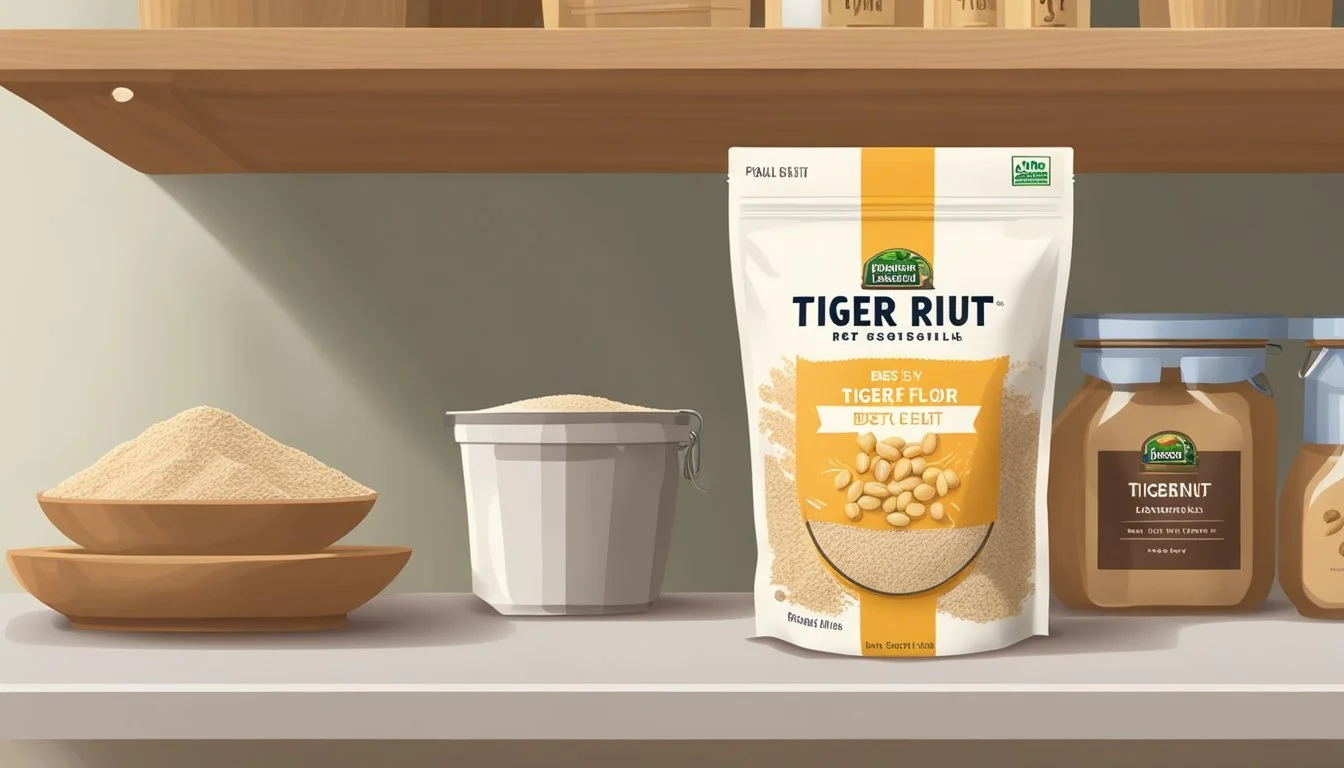How Long Does Tigernut Flour Last?
Shelf Life and Storage Tips
Tigernut flour, a valued commodity in the health food market, is derived not from nuts but from the root of the Cyperus esculentus plant. Recognized for its nutty flavor and versatility, it's a go-to ingredient for those with nut allergies and those following gluten-free or paleo diets. The shelf life of tigernut flour, however, differs significantly from that of traditional grain-based flours.
After opening, tigernut flour maintains its quality for several weeks at room temperature, which is considerably less than the shelf life of all-purpose flour and other common flours. To preserve its freshness and extend its usability, storing tigernut flour in the refrigerator or freezer is recommended, which can prolong its life for up to 2 to 3 months. The naturally sweet profile of tigernut flour, comprised mainly of carbohydrates, makes it a desirable addition to various baked goods, reducing the need for added sugars.
Tigernut Flour Basics
In this section, the focus is on defining tigernut flour, outlining its nutritional profile, and comparing it to other flours. Tigernut flour is increasingly popular among various dietary preferences for its unique qualities.
What Is Tigernut Flour?
Tigernut flour is derived from tigernuts, which, contrary to their name, are not nuts but tubers from the plant Cyperus esculentus. This makes the flour nut-free, gluten-free, and suitable for a paleo diet, as well as for those with nut allergies. The flour is created by drying and grinding tigernuts into a fine powder, which has a sweet, nutty flavor, despite it being a root vegetable, making it an appealing addition to various culinary applications.
Nutritional Profile of Tigernut Flour
Tigernut flour is known for its impressive nutritional value, being rich in fiber and resistant starch, which can aid in digestion. Here's a brief overview of its nutritional content per 1/4 cup serving:
Calories: Generally around 120-150
Carbohydrates: Approximately 16-20g, out of which sugars are about 2-5g
Fiber: Around 7-10g, contributing to a feeling of fullness
Proteins: About 2g, less than other flours
Fats: Contains healthy fats, with 5-7g per serving
Vitamins and Minerals: Notably high in potassium, iron, magnesium, calcium, and zinc
This nutritional profile makes it not only a healthful choice for general diets but also suitable for those following an autoimmune protocol (AIP) diet due to its non-inflammatory properties.
Comparing Tigernut Flour to Other Flours
When compared to other flours, tigernut flour stands out because it is grain-free and gluten-free. Its carbohydrate level is higher than almond flour but lower than traditional wheat flour. Additionally, the natural sweetness inherent in tigernut flour can reduce the need for additional sugar in recipes. The high fiber content also differentiates it from many other flours, beneficial for those seeking to increase their dietary fiber intake. Tigernut flour's nutritional profile and usability in baking and cooking make it a versatile ingredient in the health food sector.
Sensory Characteristics of Tigernut Flour
Tigernut flour offers distinct sensory characteristics that cater to both taste and textural preferences. This section explores the flour's sensory profile in detail.
Flavor Profile
Tiger nut flour is characterized by its sweet and nutty flavor, despite the absence of nuts. This unique taste stems from its root vegetable origins and is naturally occurring. The sweetness level is moderate, which makes the flour versatile for various culinary applications. Some describe the sweetness as subtly comparable to that of coconut flour.
Texture and Consistency
Tigernut flour presents a texture that is less starchy than other alternatives like cassava flour. It's known for a fine, granular consistency and a slightly gritty nature, which is markedly different from the silkiness of wheat flours. The texture of tigernut flour can impart a unique mouthfeel to baked goods, often described as hearty or robust. Since it is lower in hard-to-digest fibers, it tends to be more easily incorporated into recipes with a lighter textural outcome.
Shelf Life Determinants
Tigernut flour's longevity hinges on a variety of factors, from environmental conditions to storage methods. These determinants dictate how long this alternative flour remains at optimal quality before spoilage occurs.
Factors Affecting Tigernut Flour's Freshness
Exposure to Air and Moisture: Tigernut flour, like most flours, is sensitive to air and moisture, which can accelerate spoilage.
Storage Temperature: Keeping tigernut flour at room temperature is standard, but excessive warmth can shorten its shelf life.
Date of Production and Labeling: The label provides a guideline for its expected shelf life, usually factoring in the date of production.
Packaging Integrity: Once opened, the packaging's ability to protect the flour from contaminants is compromised.
Optimal Storage Conditions
Temperature Control: Storing tigernut flour in a cool, dry place, ideally at consistent room temperature, is crucial for preservation.
Airtight Containers: To extend its shelf life, transfer the flour to airtight containers after opening.
Refrigeration Options: For longevity beyond a few weeks, refrigeration or freezing can preserve tigernut flour for up to 2-3 months.
Moisture Prevention: Using desiccants or ensuring the storage environment is dry can help prevent moisture-related spoilage.
By adhering to these optimal conditions, consumers can effectively manage tigernut flour's shelf life.
Culinary Uses
Tigernut flour is appreciated for its versatility in cooking and baking due to its unique qualities. It is naturally sweet and nut-free, making it ideal for various dietary needs.
Tigernut Flour in Baking
Bakers often turn to tigernut flour when preparing gluten-free and grain-free baked goods. It imparts a natural sweetness, reducing the need for added sugars. This flour is not identical to all-purpose flour, so proportions may vary; for instance:
For cookies and muffins: Substitute 75% tigernut flour for all-purpose flour; if a recipe requires 1 cup of all-purpose, use ¾ cup of tigernut.
For breads and pancakes: Mix tigernut flour with other gluten-free flours like coconut or arrowroot for improved texture.
When baking with tigernut flour, it is essential to sift the flour to avoid lumps and ensure a fine, consistent texture in the final product.
Alternative Recipes
Tigernut flour isn't limited to just sweet confections. It can serve as a binding ingredient in:
Veggie burgers and black bean patties to hold their shape better.
Soups and stews where it acts as a thickener, much like tapioca or arrowroot starch.
These uses cater to both vegan and nut-free diets, broadening the scope of tigernut flour beyond traditional baking.
Tigernut Flour Substitutes
In some recipes, tigernut flour can replace other common flours, but the reverse holds true as well. When it's not available, suitable substitutes may include:
Almond flour: Similar consistency but not nut-free.
Coconut flour: Lower in carbohydrates but may require increased liquid.
Cassava flour: A more starchy option.
Substitutes should be chosen based on the desired texture, dietary restrictions, and flavor profile of the dish.
Purchasing and Availability
Tigernut flour, a valued specialty ingredient, is increasingly accessible both in physical retail locations and through online platforms, offering a variety of brands for consumer selection.
Finding Tigernut Flour
Tigernut flour can be found in a multitude of locations, both geographically and in terms of retail type. Health food stores often stock this product due to its dietary benefits and rising popularity among niche diet followers. For online shoppers, numerous e-commerce sites provide an array of tigernut flour options with the convenience of home delivery. Geographic regions such as Africa, the Mediterranean, India, and the Middle East have a history of using tigernuts and may offer local brands in both urban supermarkets and local markets.
Selecting the Right Brand
When choosing a brand of tigernut flour, consumers should pay attention to the product's origin and manufacturing processes. Brands that specialize in or are based in regions where tigernuts naturally thrive tend to offer authentic products. It's advisable to look for tigernut flour that has clear labeling regarding shelf life and storage recommendations to ensure quality and longevity. Some leading brands may also emphasize organic and non-GMO certifications, catering to those who prefer products with minimal processing and no synthetic additives.
Dietary Considerations
Tigernut flour is a versatile substitute catering to various dietary needs due to its unique composition, which strikes a balance between carbohydrates and dietary fiber. It's particularly well-suited for individuals following specific health-focused diets.
Tigernut Flour in Special Diets
Paleo Diet: Tigernut flour is appropriate for a paleo diet as it is derived from tubers, fitting within the grain-free and gluten-free parameters of paleo guidelines.
Keto-Friendly: Though high in carbohydrates relative to other keto foods, tigernut flour's natural sweetness allows for minimal additional sugar in recipes, which may make it suitable for those on a ketogenic diet with higher carb allowances.
Autoimmune Protocol: As a non-nut and grain-free option, tigernut flour is also acceptable for individuals adhering to the autoimmune protocol, which often restricts grains and nuts.
Vegan and Gluten-Free: Additionally, tigernut flour is both vegan and gluten-free, providing a health food alternative for those avoiding animal products and gluten.
Allergen Information
Nut-Free: Despite its name, tigernut flour is actually made from a tuber, not nuts, making it safe for individuals with nut allergies.
Gluten and Grain-Free: It does not contain gluten or grains, which is beneficial for those with gluten sensitivities or celiac disease.
By catering to such a wide array of dietary restrictions, tigernut flour serves as a health food ingredient that supports inclusive nutrition.
Tigernut Flour in the Kitchen
Tigernut flour is a versatile pantry staple, beneficial for its nutrient content and natural sweetness. Proper preparation and storage are key to maintaining its quality and longevity in the kitchen.
Preparation Tips
When using tigernut flour, chefs should consider its natural sugar content and mild sweetness, which may reduce the need for additional sugar in recipes. It is an excellent binder and works well in combination with other flours to achieve the desired consistency in baked goods. Since tigernut flour is naturally gluten-free, it's commonly mixed with other gluten-free flours such as coconut and almond to improve texture and flavor. Adding a pinch of sea salt can enhance the flavors in recipes that include tigernut flour.
Storage After Opening
Once a bag of tigernut flour is opened, it is imperative to store it properly to retain its nutrients and prevent spoilage. It should be stored in an airtight container, away from heat and light, and kept at room temperature. For extended shelf life, chefs may opt to store it in the refrigerator or freezer, which can keep it viable for up to 1 to 2 years. It is crucial to ensure the flour does not come into contact with any liquid during storage, as moisture can lead to rancidity.
Health Benefits
Tigernut flour offers several health benefits, particularly in the context of digestive wellness and nutrient contribution. This section explores these benefits in greater depth.
Digestive Health
Tigernut flour is known for its high fiber content, which aids in digestion. The flour contains a type of fiber known as resistant starch, which functions similarly to soluble fiber. Resistant starch resists digestion in the upper part of the gastrointestinal tract and ferments in the large intestine, serving as a prebiotic that promotes the growth of beneficial bacteria. Furthermore, compared to other flours, tigernut flour is lower in fibers that are hard to digest, making it suitable for individuals with sensitive stomachs.
Nutrient Contribution
Tigernut flour is not only a source of dietary fiber but also offers a substantial nutritional value. It provides healthy fats, predominantly monounsaturated fat, which can support heart health by maintaining favorable blood sugar levels. Additionally, tigernut flour contains an array of nutrients, including vitamins and minerals, necessary for overall well-being. It provides a natural sweetness, meaning that less additional sugar is needed for sweetened tigernut flour recipes, potentially contributing to more stable blood sugar levels post-consumption.
Cultural and Historical Significance
Tigernuts, despite their name, are not nuts but tubers with a storied past that spans continents, cultures, and centuries.
Origins of Tigernuts
The history of tigernuts begins in Africa, where they are known to have been a vital food source for early humans. Scientifically referred to as Cyperus esculentus and commonly known as yellow nutsedge, these tubers are indigenous to parts of the continent. Historical evidence suggests their consumption dates back to ancient Egypt, where they were used not only as food but also medicinally.
Tigernuts Around the World
The use and cultivation of tigernuts spread from Africa into the Mediterranean basin and the Middle East. In these regions, tigernuts became a dietary staple and contributed to the culinary traditions. Most notably, in Spain, tigernuts are the primary ingredient in horchata, a sweet, milk-like beverage that remains highly popular. The influence of tigernuts has also reached as far as India, where it continues to be utilized for its flavor and nutritional properties.
Social and Online Presence
In recent years, the use of tigernut flour has seen a steady rise within various dietary communities, surfacing in online conversations and social media platforms. This digital engagement reflects the growing interest in alternative flours compatible with specific diets such as paleo and vegan.
Tigernut Flour Trends
Instagram has become a treasure trove of visual inspiration for tigernut flour enthusiasts. One can find a multitude of tigernut flour recipes with a simple hashtag search, such as #tigernutflour. These recipes often cater to individuals following paleo diets or a vegan lifestyle, emphasizing the flour's versatility. Content creators on Instagram share everything from baked goods to savory dishes, providing a glimpse into the flour’s capability to transform traditional recipes into diet-compliant delights.
Popular Recipes:
Tigernut pancakes
Chocolate chip cookies
Vegan brownies
Engaging with Communities
Tigernut flour companies and users engage in direct conversations with their audience through platforms like Instagram, sharing tips and soliciting feedback. They participate in community discussions, offering insights into the flour's longevity, optimal storage practices, and innovative ways to use it in the kitchen. This proactive engagement aids in creating a knowledgeable base of consumers who understand not just how to use tigernut flour, but also how to store it effectively to maintain freshness.
Discussion Topics:
Storage tips to extend shelf life
Creative uses in recipes
Nutritional benefits relevant to diets











